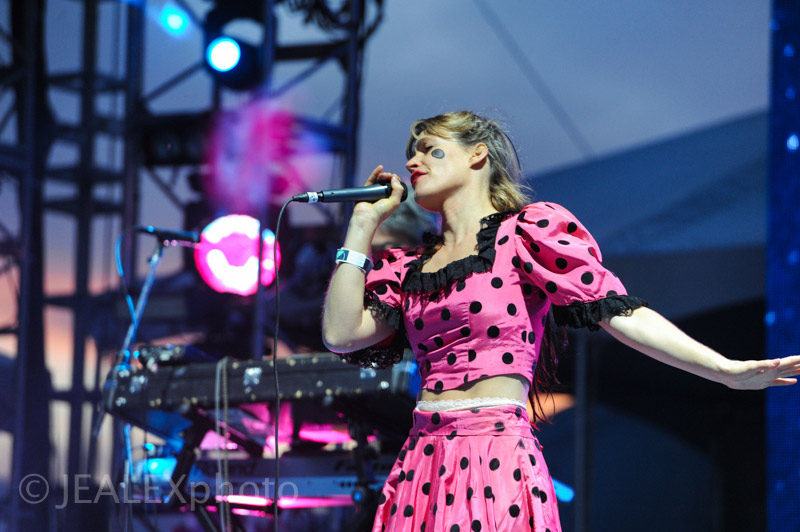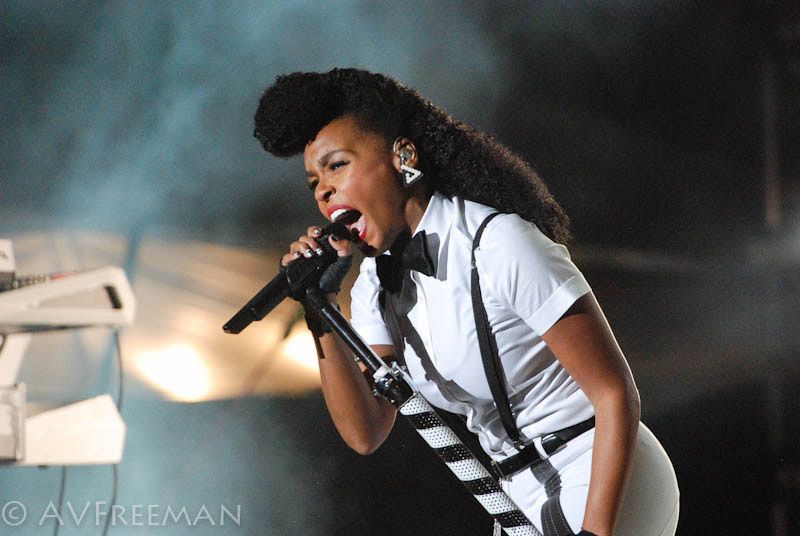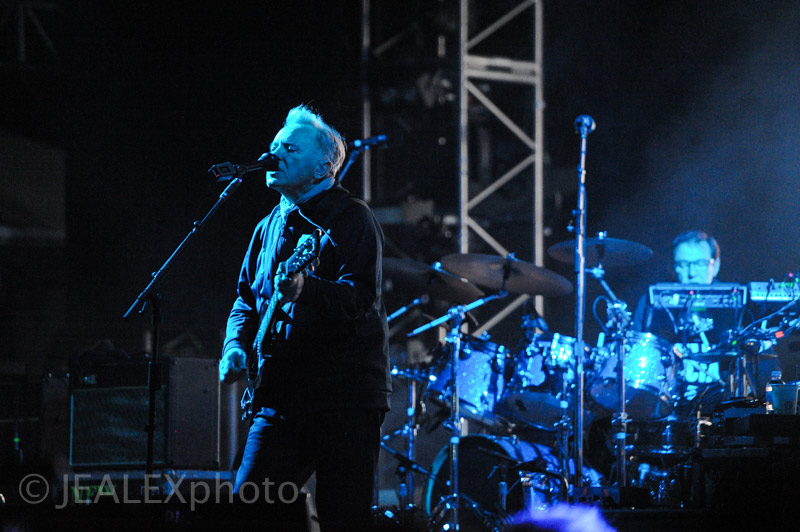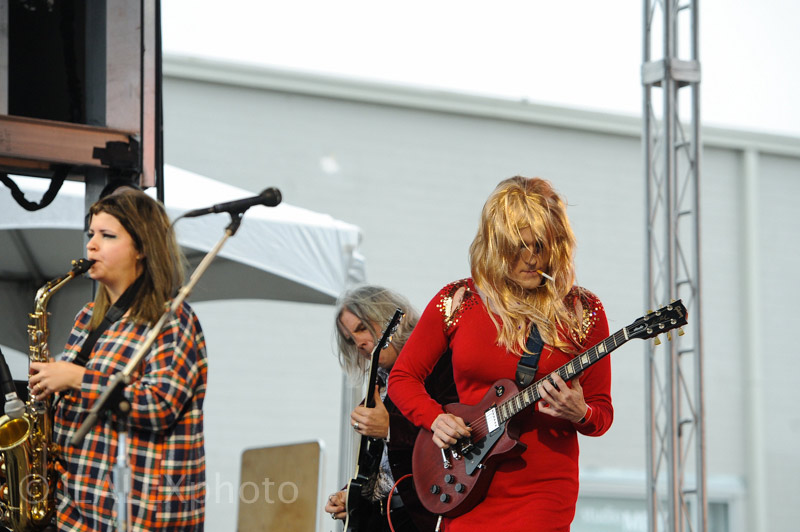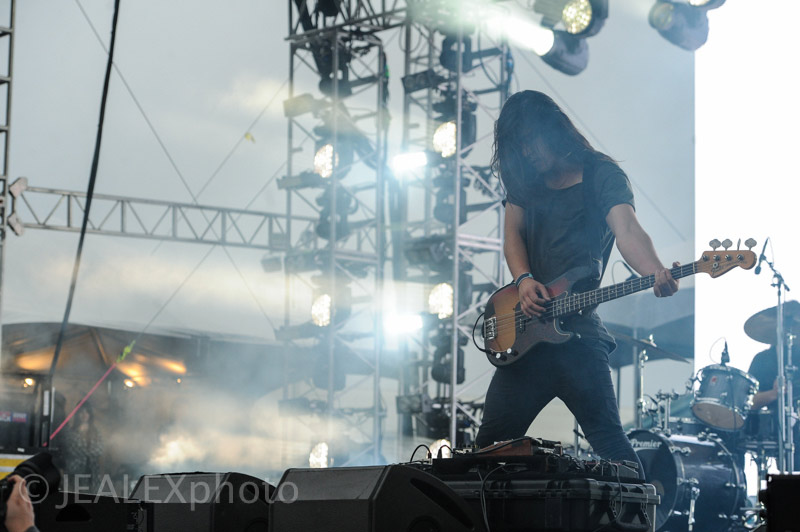
 The Winter Street Studio is six acres of warehouses nestled deep in an industrial complex within view of the towering Houston skyline, and serves as one of several major hubs for artistic activity in the Bayou City. The studios, corridors, and open spaces served as the backdrop for the city’s newest music festival offerings, Day For Night, Saturday & Sunday, December 19th & 20th.
The Winter Street Studio is six acres of warehouses nestled deep in an industrial complex within view of the towering Houston skyline, and serves as one of several major hubs for artistic activity in the Bayou City. The studios, corridors, and open spaces served as the backdrop for the city’s newest music festival offerings, Day For Night, Saturday & Sunday, December 19th & 20th.
Day One of Day for Night kicked off on a seasonably cool day – a bit of a breeze and bright clear skies – with the Philip Glass Ensemble. Walking into the cavernous space inside the Green Stage alluded to the scale of acts and visuals that would engulf viewers over the next two days. Glass commanded a large crowd for his early set, with the “older than usual” festival audience crammed into the narrow general space to catch a glimpse of one of the most influential living American composers. People drifted in and out of the Green Stage area, some delighted while others puzzled by what they had just heard, rhythmical and repetitive musical structures that set the stage for the kinds of artsy, non-top 40-learning musical acts that would dominate a good part of the lineup during the fest.

Adjacent to the Green Stage were corridors and studios set up with complementary video art installations that commanded their own presence, especially Casey Reas, who anchored the area with his wall-size projection of what looked like a scrambled transmission from outer space with figures moving through contrasting grids of blue and green pixels. People stood at the back of the room and sat on the floor as the soundtrack of thundering sub woofer bass rattled them to their cores. Outside of Reas’ space was a long corridor that blanketed the art viewers in the warm glow of a simulated sunset.

The main inside studio corridor was flanked by a number of other video installations that ranged from the Night Moves video of black, white, a greyscale gradients of moving triangles, circles, and lines to Kamil Nawratil’s video of candy-colored bubbles flowing together to make shapes reminiscent of what you would see under a microscope, both with similar atonal minor key soundtracks. Alex Czetwertynski’s white-washed floral sculptural bathed in kaleidoscopic lighting and Gabriel Pulecio’s clear Plexiglas box filled with light-emitting pulsating wave forms, although riffing on the same scientific and biological theme, were the only two installations in that area with a sculptural presence. Bookending this main indoor exhibit space was the large gallery that housed the work of the School for Poetic Computation – a two-channel video installation that projected lines of command codes on the right with their corresponding actions that were expressed in white line graphs and patterns reminiscent of a Joy Division t-shirt design on the left.
Navigating the festival was fairly easy and not nearly as visually interesting during the day, the Blue Stage was outdoors and near the Green Stage and indoor art exhibits, and the Red Stage was on the far end of the grounds. The Red Stage was a installation in it’s own right though – set on a muddy lot, the entire GA area was elevated on plywood and covered in Vegas-worthy wall-to-wall carpet with video screens galore. Watching people huddle up in groups to watch the musical acts through these large screens was certainly a unique part of the experience – some folks were literally mummy-wrapped in blankets and lying on the ground as if they were having a sleep over. Shamir was the first major act on the Red Stage; his gender-bending brand of electro pop energized the crowd during the late afternoon sun. CocoRosie continued the good vibes with their colorful outfits and saccharine sweet voices as the sun began to set behind their stage.
At dusk, the festival really began its transformation. The sides of warehouse buildings and ordinary corridors now glowed alive with pulsing projected light. The larger outdoor artworks were a visual playground that drew the passive and active engagement of a diverse audience. The wintery projection on one warehouse wall was well received. Rhyming with the circular motif found through the fest, this projection was dots of light floating around like snowflakes – many in the audience were jumping and grabbing at the dots of light as if they could be actually held. MASOMENO’s projections varied throughout the day, but were generally made up of colorful volumetric shapes and geometric patterns that was a wildly popular place for people to take selfies. In two main areas of the festival grounds were curated groups of food trucks that reflected Houston’s diverse population and culture – hungry festival-goers had the hard decision whether to go Cajun, Mexican, Asian, or soul food.

Other works in at the festival were more active in audience participation. Zach Lieberman’s work, for example, was a partially programmed and a partially audience-driven artwork. Using what looked like an opaque projector, viewers could rearrange shapes on a light table to interact with the patterns beamed against the wall of a warehouse. Refik Anadol’s ‘Infinity Room’ was also very popular. It was a lone white cube that sat in the middle of the food courtyard near the outdoor projections. Only eight people could inhabit the space at one time and the line stayed long throughout the duration of the festival, usually with around 100 or so viewers waiting their turn. What greeted them was an intimate space where every inch of the inside surfaces held funhouse mirror-like material. As viewers stood inside, four light projectors beamed striped patterns across their bodies creating a feedback loop of reflections that dazzled the eye.

The two headlining acts on Saturday night made magnificent use of the video screens on the main Red Stage. Janelle Monae’s bubbly, and sometimes hammy, stage act set up in minimal black and white swirl patterns got the crowd jumping – people danced on the carpet illuminated by a large monitor set close to the ground and the stage wide screens that flanked the main performers on either side. New Order’s highly anticipated last show and only U.S. date of 2015 closed out the day. They began their nearly two hours set with a projection of documentary-style ‘70s footage that broke into more abstract imagery that activated the impressive wall of screens that flanked the stage. The crowd sang along deep into the night as they performed hits such as “Bizarre Love Triangle”, “Blue Monday”, and Joy Division’s “Love Will Tear us Apart”.
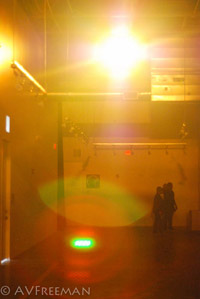 Day Two at Day for Night started off rather slow, but when the crowds did arrive, they were larger and noticeable younger than the previous day. As a little known (and frankly a little hard to describe) festival, brought to you by the folks that curate a better known Houston festival, Free Press Houston’s Free Press Fest, the videos and images shared on social media along with the word of mouth seemed to have spurred the curiosity of those not intending to go the previous day – though a good amount of the crowd could be attributed to the eleven Grammy award-nominated headliner, who would have attracted a crowd despite the location of his show. The lineup for Day Two was definitely more electronic focused; barely a band (in the traditional sense) was on the lineup that cloudy and more humid final day.
Day Two at Day for Night started off rather slow, but when the crowds did arrive, they were larger and noticeable younger than the previous day. As a little known (and frankly a little hard to describe) festival, brought to you by the folks that curate a better known Houston festival, Free Press Houston’s Free Press Fest, the videos and images shared on social media along with the word of mouth seemed to have spurred the curiosity of those not intending to go the previous day – though a good amount of the crowd could be attributed to the eleven Grammy award-nominated headliner, who would have attracted a crowd despite the location of his show. The lineup for Day Two was definitely more electronic focused; barely a band (in the traditional sense) was on the lineup that cloudy and more humid final day.

More concertgoers equaled more art viewers on Day Two; lines for the Infinity Room, Vincent Houze’s room, and Nototak Studio work were even longer than the day before. Nototak Studio’s installation was perhaps the biggest showstopper on the grounds. The warehouse was nearly the size of two football fields and contained two warehouse-sized ten-foot tall, framed grids of lead pipe with strobe lighting on the perimeter flashing at various intervals. The soundtrack was unsettling, much like the other soundtracks for the works on view, with “fingernail on the chalkboard-like” industrial sounds that verged on noise. Vincent Houze with AV&C’s room was a little more contemplative. A pyramid created from shear fabric occupied the center space of the installation and people queued up to sit inside the light sculpture. Projections of lines and other shapes reflected off of the fabric’s surface while simultaneously penetrating it onto the carpet and seated viewers.
Closing out the middle of the music lineup for Sunday, were the aggressive vocals of Death Grips and B L A C K I E, the building operatic rhythms of Nicolas Jaar, and laid back vibes of Com Truise – all of them commanding larger crowds than the previous day. Dan Deacon’s participatory performance that included choreographing a dance-off in the center of the cavernous Green Stage space served to further involve the audience and have them be part of the artworks that are his performances.
Headlining act Kendrick Lamar also made the crowd a portion of his set by welcoming not one, but two rappers from the audience to perform, to the chagrin of some who thought it didn’t add much and took away from hearing songs like “These Walls” that he didn’t perform that evening. But that’s all right, it’s Kendrick Lamar and Houston loves him. He worked through his material, equal parts To Pimp a Butterfly and good kid, m.A.D.D. City, with ease, making his hits rain on the crowd through his sounds and visuals. The organizers of this newborn festival should be applauded for bold move to incorporate art with a capital A as a major part of a music festival. The location was ideal because it truly had enough room to make it turn day into night inside the installations and night into day during the evening performances. This will be hard to top next year.
-words: Alex Freeman
-photos: Jessica Alexander and Alex Freeman










